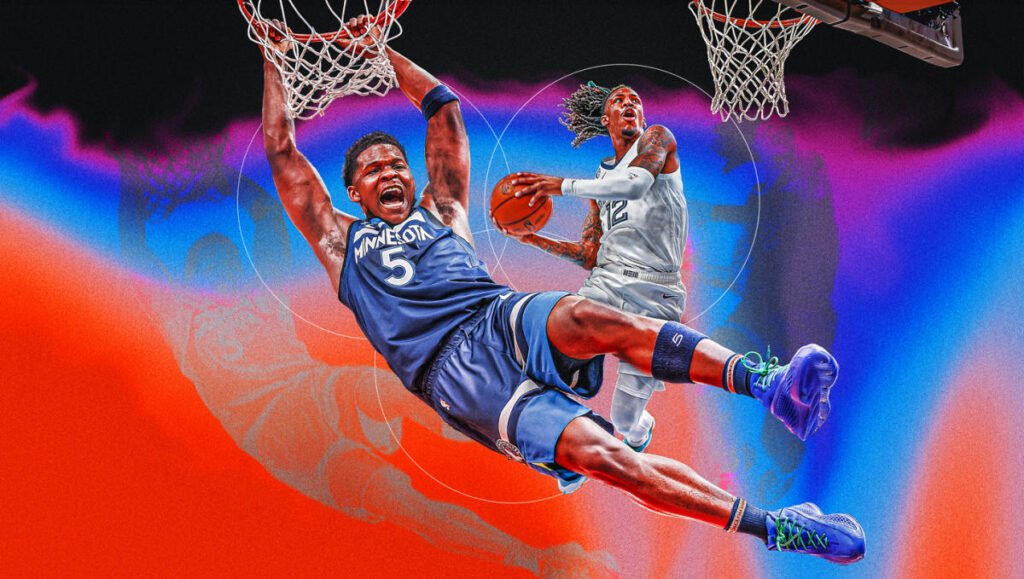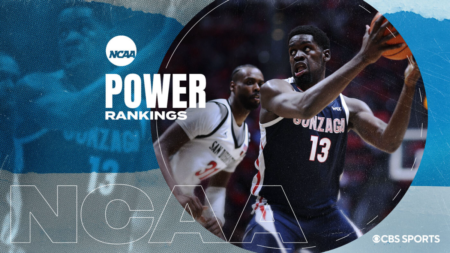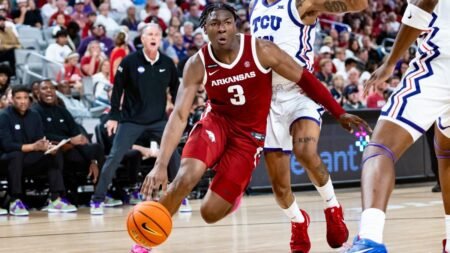Ja Morant is back and has Brook Lopez turned around. It’s November, and the electric point guard is leading the fast break in the third quarter against a porous Milwaukee Bucks transition defense. The slow-footed Lopez is the only obstacle between Morant and a thunderous finish at the basket. With Morant going downhill, this is a viral moment waiting to happen.
But instead of jetting through Lopez for a rim-rocking dunk, Morant does something unexpected. He slams on the brakes and pulls up for a 3-pointer, missing badly off the far side of the rim.
Morant didn’t dunk on that possession. Which, surprisingly, has been commonplace for the 25-year-old phenom.
This season, Morant hasn’t dunked at all. In eight games, Morant has not completed a single dunk, missing both of his attempts (including this all-time blooper). Coming back from shoulder surgery, his dunk-attempt rate is a sliver of what it used to be. His 360 layups are a thing of beauty, but dunks they are not. Meanwhile, Morant, a poor 3-point shooter, continues to launch freely from deep.
Morant represents the face of a growing grumble around the sport, that the product is suffering because the math says players should fire up 3s at a high rate, which some feel is at the expense of thrilling dunks at the rim.
On opening night, after the Boston Celtics launched 61 3-point attempts in a sleepy rout over the New York Knicks, FS1’s Nick Wright, in a clip from his What’s Wright podcast that generated millions of views on X, lamented the modern playing style and called for the league to change its rules. Among Wright’s proposals was the suggestion that the NBA should make dunks worth three points to incentivize a better product for fans who, as the tumbling ratings suggest, appear to be increasingly disenchanted with the television offering.
“I know this sounds insane,” Wright said, “but at its core, the NBA is at its best when dudes are flying over people, meeting ’em at the rim. That is when it’s at its best television product. A bunch of finesse guys hanging out at the 3-point line hoisting 30-footers is not good TV.”
So let’s try this on for size. What if dunks were worth three points instead of two? Would Morant have attempted to dunk on Lopez? How would that change alter the game? And is it addressing a problem worth trying to solve?
I asked coaches, GMs and basketball experts about whether 3-point dunks would solve the NBA’s current predicament and the answers slowly revealed what is really lost in today’s game.
Slamming the 3-point dunk idea
With the Celtics running away with the 2024 NBA Finals armed with a historically heavy dose of 3-pointers, NBA teams have copied Joe Mazzulla’s blueprint and smashed through previous high marks of 3-balls this season. After settling at about 35 attempts per game the last few seasons, teams are launching with more fervor than ever before. On average, teams are attempting a record 37.4 triples per game this season, the largest year-over-year increase in about a half-decade, according to Stathead.com tracking.
This was supposed to generate more dunk opportunities. Opposing big men have been pulled away from the basket. Driving lanes have opened up. Dunkers should be cleared for takeoff. However, despite wider pathways to the basket pried open by shooters anchored around the perimeter, the frequency of dunks has remained fairly flat in recent years.
Last Friday, Anthony Edwards, who is widely considered among the game’s best in-game dunkers, delivered a ferocious slam over Kings center Domantas Sabonis. Those who want more of those highlight reel plays from Ant can thank former NBA vet Corliss Williamson. Ahead of the game, Williamson, now a Timberwolves assistant coach, made a comment to Edwards that he was “playing soft” this season. Edwards took it to heart evidently. “I told him I was gonna dunk on one of they a****,” Edwards shared with reporters after the game.
Edwards, like Morant, isn’t dunking like he used to. Edwards’ slam over Sabonis was just his seventh dunk of the year, a season in which he has seen his dunk rate sliced in half. Meanwhile, he’s now shooting 11.3 3-pointers a game, up from 6.7 per game last season. It isn’t hard to see how Williamson’s “soft” comment could be code for “shooting too many 3s.”
DeMar DeRozan, 35, is another skywalker who has yet to dunk this season after tallying 18 slams last season in Chicago. Part of that decline can be chalked up to his age, but it’s also indicative of a league that’s increasingly asking its wings to opt for the long ball. Utah backcourt mates Collin Sexton and Jordan Clarkson have yet to dunk after logging 36 combined slams last season, per Stathead.com tracking. Guards in today’s game dunk 0.32 times per game, down 8% since last season.
So, make dunks worth three points. Easy fix, right? Not so fast. Canvassing the league, I found the 3-point dunk isn’t being met with open arms.
“Going to the rim is still more advantageous than a 3,” said one team’s top basketball executive, “so I don’t think you need to increase dunk points.”
There’s truth in the data. On average, a field-goal attempt located in the restricted area generates 1.32 points, which is more valuable than a 3-point shot, which yields 1.08 points. But that only scratches the surface of the value of a rim attack. The basket area is typically where shooters generate precious foul calls and those opportunities become instantly more valuable once the whistle is blown. In a sense, the extra value of a dunk attempt is already baked into a team’s calculus. Which is why there are still more shots in the paint than beyond the 3-point line in today’s game.
Another concern about the 3-point dunk rule? Violence.
“Injury seems like a more likely outcome,” said one Western Conference executive.
Early last season, Edwards missed two games with a hip injury after crashing hard to the floor trying to dunk over OKC’s Jaylin Williams. Williams’ teammate, Chet Holmgren, wasn’t so lucky earlier this month. After a similarly vicious crash to the floor trying to prevent a dunk attempt by the soaring Andrew Wiggins, Holmgren fractured his hip and will be out for at least two months, jeopardizing the Thunder’s title quest and all but vaporizing his All-Star chances.
As I wrote earlier in the season, the league is already facing an injury crisis. Raising the stakes to incentivize players to collide in midair at full speed doesn’t seem like a sustainable solution to the NBA’s existing problems. Don’t forget about the issue of injuries from striking the rim with your hand. (Drew Gooden once claimed he needed “seven or eight years” to heal from a wrist injury suffered while dunking.)
Instead of making dunks worth three points, another league executive co-signed one of Wright’s proposals from his aforementioned podcast: make 3-pointers worth four points and 2-pointers worth three points. “But I doubt folks would go for that,” the executive conceded.
I reached out to Nick Elam, the Ball State professor and inventor of the Elam Ending basketball innovation that was adopted by the NBA for All-Star Games and the The Basketball Tournament for his thoughts on Wright’s proposal to increase the reward for a dunk. He initially felt himself getting swayed by the merits of such an idea. It would likely reduce the number of 3-point shots and make for a more entertaining game, he surmised. But eventually, he wasn’t convinced the potential benefits outweighed the downsides.
One obstacle, he pointed out, is the tricky matter of officiating. If a player fouls Morant on a layup, who’s to say that it wasn’t a dunk attempt and thus warrant three free throws?
“We’ve never had to care [about that],” Elam said. “But under a 3-point dunk rule, we would have to care. We’d have to care so much that these types of fouls regularly result in challenges, replays, controversies with no clear or satisfying outcome, and so on.”
Yeah, no thanks. We could avoid that problem by making all fouls inside the 3-point arc two-shot fouls.
But there’s another downstream issue: What’s a dunk? We’d have to deploy the NBA’s player-tracking cameras on the hoop or put some sort of volleyball antenna on the rim to tell us whether a player actually “dunked” the ball. I’m already dreading the replay reviews.
Tinkering with the point system seems like a noble exercise, but these ideas wouldn’t do enough to address the heart of the problem raised by Kirk Goldsberry:
Everyone’s shooting the same damn shots.
The shot-desert problem
Elam calls them “shot deserts.” He believes that solving the NBA’s problem starts with filling in the areas of the floor — specifically, the mid-range zone, which is outside the paint and inside the 3-point arc — that have been abandoned by teams looking to squeeze every morsel of efficiency out of every possession.
Since 3s are worth 50 percent more than 2s, and they convert at about the same rate as mid-range jumpers, it doesn’t take a rocket scientist to figure out why teams prefer one over the other. And now it seems everyone is wise to the math that has resulted in what feels like a widespread sameness to the league.
“Yes, there are too many 3s — offensive possessions are stagnant and predictable,” Elam told Yahoo Sports. “For several years, large shot deserts have emerged on NBA courts, essentially anywhere inside the 3-point arc, except within arm’s reach of the rim. The sport is in need of recalibration to distribute shots more evenly around the court.”
The numbers show a massive migration. In 1996-97, the first season of shot-location data, the Michael Jordan-led Chicago Bulls paced the league with 41.5 mid-range shots per game while the average team took about 32 attempts from that area. Over time, as analytically driven basketball minds began to see the wasteful average payoff of 20-footers, heaps of those same jump shots got pushed beyond the 3-point line.
“Yes, there are too many 3s — offensive possessions are stagnant and predictable. The sport is in need of recalibration to distribute shots more evenly around the court.”Nick Elam
This season, the leading purveyors of the mid-range, the Sacramento Kings, take just 14.1 shots from the same area that Jordan enjoyed, with the majority of the NBA taking single-digit attempts per game.
The crazy thing? It’s gotten to the point that teams will go entire games without scoring from the mid-range area at all. This is what I’ll call the desert games.
Remarkably, this season there have been 24 instances in which a team did not score a single point in the mid-range area, according to NBA.com/stats tracking. This is a mind-boggling figure. For decades, we never saw one such game — even as recently as 2010-11. Then one. Then two. Soon, 13. A big jump in 2018-19 to 64 (the Moreyball Rockets won 65 games the year before). Then, a plateau around 80 such games.
Until this season.
This season, we’ve already seen 24 such games, which means we’re on track for — get ready for this — 136 desert games. It happens almost every night now.
The problem of league-wide sameness that Wright and Elam describe doesn’t just bear out in the sheer number of desert games. In a fascinating twist, desert games are not the exclusive property of one radical NBA team — say, the Boston Celtics — looking to hyper-emphasize the 3-point shot. In reality, 14 different teams this season have played an entire game without scoring in the mid-range. And it’s not just the good teams. Up and down the standings, teams have abandoned the mid-range. The league’s leader in desert games? The 3-11 Utah Jazz.
This is a radical change in strategy that has transpired right before our eyes. When Stephen Curry came into the league in 2009, we went the entire season without seeing a desert game. Curry was the transcendent shooter that lit the fire. James Harden/Moreyball fanned the flames. The Celtics poured gasoline on it. Now it’s wildfire spreading across the league.
In 2022, I had the opportunity to moderate a panel at the MIT Sloan Sports Analytics Conference called NBA 75 to 100: The Future of the Game. Among those on the panel sat JJ Redick, now the head coach of the Los Angeles Lakers, and Daryl Morey, who leads the Philadelphia 76ers’ front office. The topic of 3-pointers inevitably came up. Redick, who played in Philadelphia for two seasons before Morey arrived, shared a story about a Sixers staffer encouraging him to trade a mid-range shot for a sidestep 3 because the percentages were better. Redick wanted to keep it in his bag.
“Sometimes,” Redick said, “in a possession, the best shot is that pull-up [mid-range] jumper.”
Fast forward two years later, Redick’s Lakers and Morey’s Sixers played a game in which neither team scored a single point from the mid-range area — that is, until LeBron James swished a 12-footer from the left baseline with 3:16 left in the fourth quarter. We were moments away from the NBA’s first-ever “shot desert” game in which both teams failed to score from the entire mid-range area, per NBA.com tracking.
Track it next time you watch an NBA game. Notice how teams rarely take the open mid-range shot, opting instead to drive into the paint and kick. Drive and kick. Drive and kick. Until an open 3 is created. Or the rim protectors cry, “Uncle.” The Celtics won a championship with this brand of basketball.
In the end, I don’t think I support the 3-point dunk rule even if I do want to incentivize the Morants and Edwardses of the world to be dunking more. From an injury standpoint, a 3-point dunk rule feels like something where the cure is worse than the disease. In such a world, high-flying athletes would be too injured to play in the long run and/or too protective of their careers to dunk every time down the floor. Can you imagine the trainwrecks in a fastbreak situation to break up a dunk? If you thought clear-path foul controversies were bad now, just wait.
Any sort of rule change has to address that we’ve abandoned a huge area of the floor. If it wasn’t apparent before, the sudden rise of shot desert games should hammer it home.
“You think the mid-range jumper is a lost art now?” Elam said. “Just wait until it is quantifiably even less efficient, relative to a dunk, than it is currently.”
Also, if dunks were worth three, I think we’re thinking about the wrong guys. It’s not the flying wings who would benefit most. I actually think the most valuable players would be the Rudy Goberts and Giannis Antetokounmpos — guys who can dunk and prevent dunks.
Who am I kidding? The MVP would probably be Victor Wembanyama. Until the end of time.
So, what’s the solution?
The NBA should look at what Major League Baseball did in 2023 to ban the shift and introduce the pitch clock. The league recognized the relentless data-driven pursuit of Three True Outcomes (strikeouts, walks and home runs) ruined the diversity of action on the field. The game became too predictable and the league took action against the rampant sameness.
In the NBA, we ultimately want to watch competition, but our attention depends on the element of surprise to keep us locked in. The game, in its current form, is lacking some of that spontaneity and creativity. If the goal is to create more shot diversity, replenish the shot deserts and make the game more unpredictable, I have three other ideas that I prefer to the 3-point dunk:
1. Abolish the corner 3
I like this concept from Goldsberry, the godfather of all basketball mapping. Eliminate the corner 3, or what he calls the loophole 3, and make the NBA’s shot economy more fair and “disincentivize loitering.”
I’m with it in theory. My main concern is that the game would be exclusively played in the middle third of the floor. Why would you go anywhere near the corners if there’s no added bonus? Maybe you can get more open shots there. But I worry that eliminating the corner 3 is creating two parallel shot deserts on the outer thirds of the floor. But yeah, dudes standing idly in the corners ain’t it either.
2. Widen the court, keep a uniform 3-point arc
This is, in some ways, the most sensible tweak in the short-term. You might say, But what about all the court-level seats that we’d lose?! My former editor/boss Henry Abbott of TrueHoop always laughed at that concern. He’d get into the basic geometry of it all and point out that a wider court creates more courtside seats for owners to sell. So what if you’d lose a few seats in the second and third row? Seems like a billionaire problem, not one for the average NBA fan. Even still, decreasing supply would likely increase demand. As one executive put it: “They would make more money if they expanded the court as fewer seats always equals more money.” To that point, have you tried to buy a ticket at Cameron Indoor Stadium?
From a basketball perspective, it doesn’t solve the shot diversity problem. I’m not sure there is a complete fix for that unless you go full Rock N’ Jock and add a 25-point basket (17 feet above the floor) and 50-point basket (25 feet and 6 inches). Watching a teenaged Kevin Garnett celebrate by screaming in Gary Payton’s face because GP hit a 50-pointer … my eyes are welling up from nostalgia.
3. Introduce the 2-3-4 system
I’m campaigning for the 2-3-4 system where there’s a deep 4-point line and a shorter 3-point line that brings back the mid-range. I’ve long-been a supporter of the 4-point line that incentivizes logo shots. They’re awesome, but slapping a deep 4-point line on the court doesn’t solve the shot desert problem.
So, we shorten the old 3-point arc. Make it 15 feet at the apex (where the nail at the free-throw line currently is now) and broaden it to about 17 feet in the corners. Anything inside it is 2 points. Take the old 3-point arc and slide it back to 35 feet. That’s the four-point line. Make it 40 feet? Sure, let’s see what happens. In between those lines, that’s the 3-point zone.
I want logo shots and mid-range shots and paint shots. I want all of it.
Basically, I want shot selection back.
Read the full article here














